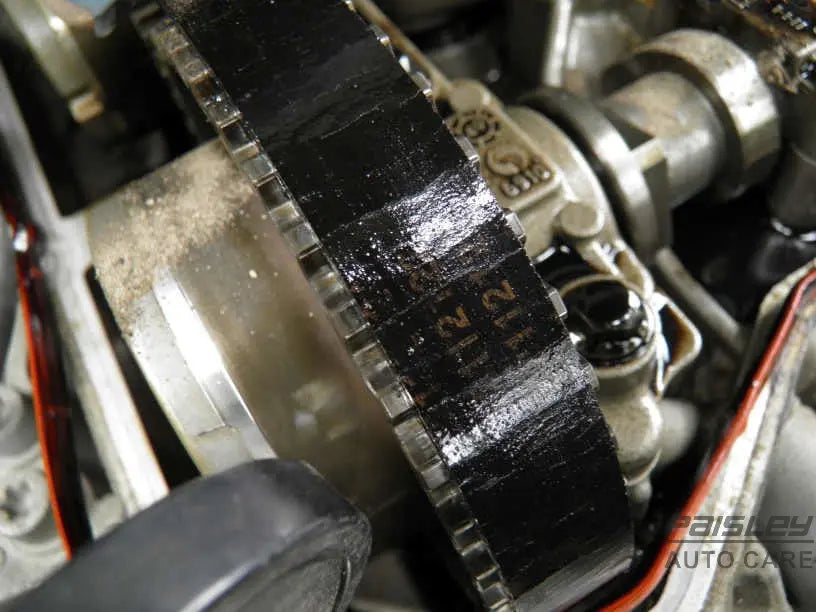Understanding Wetbelts
At Paisley Autocare, we often get asked about specific engine components and what can go wrong with them. One such component that’s generated a lot of interest recently is the wetbelt. While not all car owners will have encountered this term, wetbelts are increasingly common, particularly in modern vehicles. Understanding what a wetbelt is and the common problems associated with it can help you make more informed decisions about maintaining your car. In this blog, we’ll dive deep into wetbelts, what they do, and why they can sometimes be a source of headaches for car owners.

What Is a Wetbelt?
At its core, a wetbelt is a timing belt that operates inside the engine, lubricated by engine oil. Unlike traditional timing belts, which are often dry and positioned outside the engine (hence the name "dry belt"), wetbelts are submerged in oil, which is meant to keep them lubricated, reduce wear, and increase durability.
The Role of the Timing Belt (Wet or Dry)
Before we look more closely at wetbelts specifically, it’s important to understand the role of the timing belt. This belt synchronizes the rotation of the engine's camshaft and crankshaft, ensuring that the engine’s valves open and close at the correct times during each cylinder’s intake and exhaust strokes. If this process is even slightly off, the engine will not run efficiently, and in severe cases, it can lead to catastrophic engine failure.
Wetbelts perform the same function but are positioned inside the engine and run in oil. They are typically narrower than dry timing belts and are often found in newer, more fuel-efficient engines.
Why Did Manufacturers Shift to Wetbelts?
The move from traditional dry belts to wetbelts is largely driven by fuel efficiency regulations and emissions standards. By running inside the engine and using engine oil as lubrication, wetbelts create less friction compared to dry belts, resulting in slightly improved fuel efficiency. They are also quieter, which contributes to a smoother overall driving experience.
Wetbelts are often found in smaller, turbocharged engines, such as Ford's 1.0-litre EcoBoost, where every bit of efficiency counts. However, while wetbelts were designed to be more durable and require less frequent replacement than traditional belts, they are not without their own unique set of problems.

Common Problems with Wetbelts
Despite their advantages, wetbelts can be prone to certain issues that every car owner should be aware of. Let’s take a closer look at some of the most common problems that can arise:
1. Deterioration Over Time
Like any part of a car, wetbelts are subject to wear and tear. Even though they are lubricated by oil, the constant motion and exposure to engine heat can cause the material to break down over time. One of the most frequent issues with wetbelts is the breakdown of their rubber components, which can cause the belt to stretch or fray. If left unchecked, this can result in the belt slipping or failing altogether, leading to significant engine damage.
2. Oil Contamination
Since wetbelts are submerged in oil, any issue with the engine oil can affect the belt. Contaminated oil, whether from a lack of regular oil changes or from engine problems such as oil sludge, can reduce the effectiveness of the wetbelt’s lubrication. When this happens, the belt can become brittle, more prone to wear, and eventually break. Regular oil changes are therefore crucial for the longevity of a wetbelt system.
3. Oil Pressure Problems
Wetbelts rely on consistent oil pressure to function correctly. If the oil pump or oil pressure regulator malfunctions, it can starve the belt of the lubrication it needs. This can lead to accelerated wear and, in severe cases, sudden belt failure. In some engines, the oil pump is driven by the wetbelt itself, meaning any issues with the belt can also affect the oil pump’s operation, creating a feedback loop of problems.
4. Engine Sludge Buildup
Sludge is the thickening of engine oil due to oxidation or contamination. In engines equipped with a wetbelt, sludge can be particularly damaging. It reduces the lubricating properties of the oil, leading to increased wear on the belt. If the belt becomes coated in sludge, its flexibility can be reduced, making it more likely to snap.
Regular maintenance, including oil changes and using high-quality oils, is essential to prevent sludge from forming and causing these issues.
5. Manufacturing Defects
While rare, some wetbelts have been known to suffer from manufacturing defects. This has been seen most notably in some of Ford’s EcoBoost engines, where the wetbelt degraded much faster than anticipated. In these cases, manufacturers have sometimes issued recalls or extended warranties to cover the cost of belt replacements, but this is not guaranteed. It’s important to check if your vehicle is affected by such issues and ensure you follow any recommended service intervals.
6. Limited Lifespan Despite Claims
One of the selling points of wetbelts is their supposedly longer lifespan compared to dry belts or chains. However, real-world experience has shown that this isn’t always the case. Wetbelts may degrade faster than initially advertised, especially if the vehicle is subjected to harsh conditions, such as frequent short trips, extreme temperatures, or inconsistent maintenance. Some wetbelts have been known to fail prematurely, requiring costly repairs.
How to Maintain a Wetbelt System
Now that you understand the potential issues that can arise with a wetbelt, it’s important to know how to minimize these risks. Here are some key tips for maintaining a wetbelt system:
1. Regular Oil Changes
As mentioned earlier, the oil in a wetbelt system plays a critical role in its longevity. Make sure to follow the manufacturer’s recommendations for oil change intervals, and always use high-quality oil that meets the specifications for your vehicle.
2. Inspect the Wetbelt at Regular Intervals
Although wetbelts are located inside the engine and not easily visible, they should be inspected periodically by a professional mechanic. If your car is due for a service or if you notice any unusual noises coming from the engine, it’s worth asking your mechanic to check the condition of the belt.
3. Keep an Eye on Oil Pressure
If your vehicle has an oil pressure gauge, pay attention to any unusual readings. Low oil pressure can be a sign that the wetbelt is not being properly lubricated, which could lead to damage. If you notice a drop in oil pressure, bring your vehicle in for a check-up as soon as possible.
4. Follow the Manufacturer’s Service Intervals
Manufacturers often provide a recommended service interval for wetbelt replacement. Even though they may claim a long lifespan, it’s always wise to follow the official guidelines to avoid any potential damage from an overdue belt.
5. Stay Informed About Recalls or Service Bulletins
From time to time, manufacturers may issue recalls or service bulletins related to wetbelt issues. Stay informed about any updates for your particular make and model to ensure your car is running as safely and efficiently as possible.
When to Replace a Wetbelt
Most wetbelts have a recommended replacement interval between 80,000 to 150,000 miles, depending on the vehicle make and model. However, if you start noticing any unusual symptoms like engine misfires, loss of power, or strange noises from the engine bay, it’s better to have the belt inspected sooner rather than later. Remember, a failed wetbelt can cause severe damage to your engine, potentially leading to a much more costly repair.
Conclusion
Wetbelts are an integral part of many modern engines, helping to improve fuel efficiency and reduce emissions. However, they are not without their challenges, and it’s important for car owners to understand the common problems associated with wetbelt systems. Regular maintenance, including oil changes and professional inspections, is key to ensuring your wetbelt remains in good condition and lasts as long as possible.
At Paisley Autocare, we are always here to help with all your vehicle’s maintenance needs. If you suspect an issue with your wetbelt or just want peace of mind, don’t hesitate to bring your car in for a service. We can inspect, advise, and replace wetbelts to ensure your vehicle stays in top condition, preventing costly repairs down the line.




